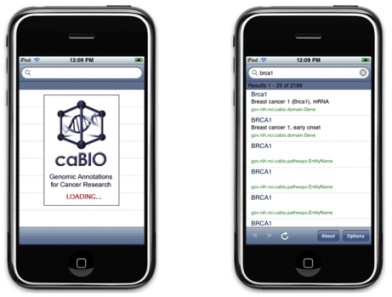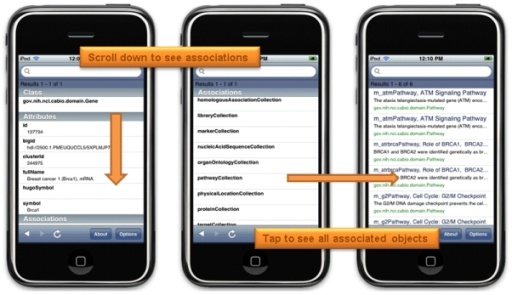To Print the Guide
We recommend you print one wiki page of the guide at a time. To do this, click the printer icon at the top right of the page; then from the browser File menu, choose Print. Printing multiple pages at one time is more complex. For instructions, refer to How do I print multiple pages?.
Overview
The caBIO iPhone Application (app) allows you to search caBIO on your iPhone or iPod Touch. This app is useful for quick searches of caBIO on the go. To use the free app, you must first download it from the App store and install it on your mobile device. A caBIO iPhone App demo is available on the app's wiki page, and a limited guide is provided below.
Browsing caBIO
The format of the retrieved records of the caBIO iPhone Application is nearly identical to the caBIO Portlet Simple Search tool, but the iPhone Application does not auto-generate a list of caBIO terms that match the characters you have entered.
To view Cancer Gene Index data, type a gene, disease, or compound/agent term into the text field at top and tap Search, as shown in the following figure from the app's wiki page. Because caBIO iPhone application does not suggest caBIO terms based upon the characters you have entered, you may have difficulty retrieving results for your exact desired term. If this is the case, try using more general the special character "*" that retrieves results will have zero or more characters in place of the asterisk (e.g., hodg* for Hodgkin's lymphoma).
The app will retrieve caBIO object records that match your search term and provide an unsorted list of objects, as shown in the following figure from the app's wiki page. Two or three pieces of information will be shown for each retrieved object : the object name in blue text, miscellaneous data specific to the object's type in black text (this may or may not be provided), and the class name in green text. Tap on any row to view the object's Attributes and Associations with other objects. The Simple view returns at most You can view all of the object's attributes and data by clicking on the blue object name link.
The maximum number of retrieved search results is 200, which you may increase from the default value of 25 by tapping the Options button at the bottom right of the GUI.


